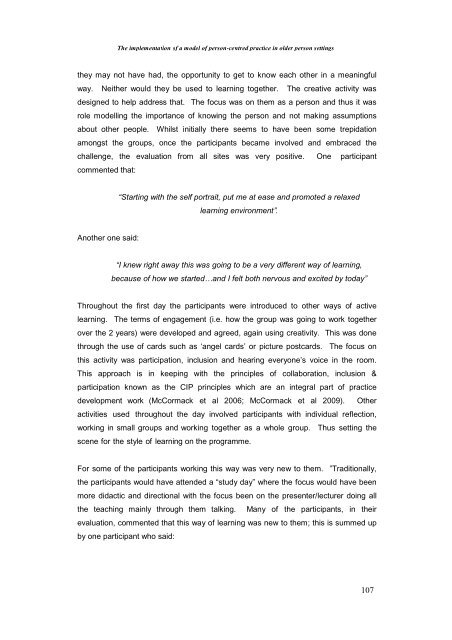The Implementation of a Model of Person-Centred Practice In Older ...
The Implementation of a Model of Person-Centred Practice In Older ...
The Implementation of a Model of Person-Centred Practice In Older ...
Create successful ePaper yourself
Turn your PDF publications into a flip-book with our unique Google optimized e-Paper software.
<strong>The</strong> implementation <strong>of</strong> a model <strong>of</strong> person-centred practice in older person settings<br />
they may not have had, the opportunity to get to know each other in a meaningful<br />
way. Neither would they be used to learning together. <strong>The</strong> creative activity was<br />
designed to help address that. <strong>The</strong> focus was on them as a person and thus it was<br />
role modelling the importance <strong>of</strong> knowing the person and not making assumptions<br />
about other people. Whilst initially there seems to have been some trepidation<br />
amongst the groups, once the participants became involved and embraced the<br />
challenge, the evaluation from all sites was very positive. One participant<br />
commented that:<br />
“Starting with the self portrait, put me at ease and promoted a relaxed<br />
learning environment”.<br />
Another one said:<br />
“I knew right away this was going to be a very different way <strong>of</strong> learning,<br />
because <strong>of</strong> how we started…and I felt both nervous and excited by today”<br />
Throughout the first day the participants were introduced to other ways <strong>of</strong> active<br />
learning. <strong>The</strong> terms <strong>of</strong> engagement (i.e. how the group was going to work together<br />
over the 2 years) were developed and agreed, again using creativity. This was done<br />
through the use <strong>of</strong> cards such as ‘angel cards’ or picture postcards. <strong>The</strong> focus on<br />
this activity was participation, inclusion and hearing everyone’s voice in the room.<br />
This approach is in keeping with the principles <strong>of</strong> collaboration, inclusion &<br />
participation known as the CIP principles which are an integral part <strong>of</strong> practice<br />
development work (McCormack et al 2006; McCormack et al 2009). Other<br />
activities used throughout the day involved participants with individual reflection,<br />
working in small groups and working together as a whole group. Thus setting the<br />
scene for the style <strong>of</strong> learning on the programme.<br />
For some <strong>of</strong> the participants working this way was very new to them. ”Traditionally,<br />
the participants would have attended a “study day” where the focus would have been<br />
more didactic and directional with the focus been on the presenter/lecturer doing all<br />
the teaching mainly through them talking. Many <strong>of</strong> the participants, in their<br />
evaluation, commented that this way <strong>of</strong> learning was new to them; this is summed up<br />
by one participant who said:<br />
107
















